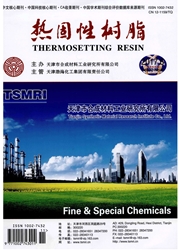

 中文摘要:
中文摘要:
采用多孔微珠为填料制备了不饱和聚酯低密度团状模塑料(BMC)。选取多孔微珠的粒径及掺量,短切玻璃纤维的长度及掺量为4因素,设计L16(44)正交试验,并结合示差扫描量热法(DSC)和扫描电镜(SEM)对复合体系的增强机理进行了研究。结果表明,制备轻质BMC材料的最佳条件为:多孔微珠的粒径〈0.710 mm,掺量4%,短切玻纤长度6 mm,掺量30%,此时制得BMC材料密度为1.314 g/cm3,弯曲强度为81.50 MPa,满足国标GB/T 23641—2009对BMC弯曲强度的要求(≥80 MPa)。多孔微珠的蜂窝壁对树脂的固化起到了阻碍作用,固化时间延长,放热不完全,同时多孔微珠的填充使得树脂基体的应力分散不均,样品的表观密度和弯曲强度降低。
 英文摘要:
英文摘要:
The unsaturated polyester low -density bulk molding compound (BMC)was prepared using porous beads as filler. The L16 (44) orthogonal test was de glass fiber length and dosage as four factors. signed selecting particle size and dosage of the porous beads, chopped The enhancement mechanism of the composite system was investigated by differential scanning calorimetry(DSC) and scanning electron microscopy (SEM). The results showed that the optimal conditions for preparing a lightweight BMC materials as followed: particle size of porous beads 〈 0. 710 mm, dosage 4% , chopped glass fiber length 6 mm, dosage 30% and the density of obtained BMC material was 1. 314 g/cm3 and the bending strength was 81.50 MPa which met the national standard GB/T 23641--2009 re- quirement on BMC bending strength (≥ 80 MPa). The curing of resin was hindered by porous microbead cellular wall. The curing time was extended and exotherm was incomplete. The stress of the resin matrix was dispersed une- venly by filling of porous microbeads and the apparent density and bending strength of the samples were decreased.
 同期刊论文项目
同期刊论文项目
 同项目期刊论文
同项目期刊论文
 期刊信息
期刊信息
